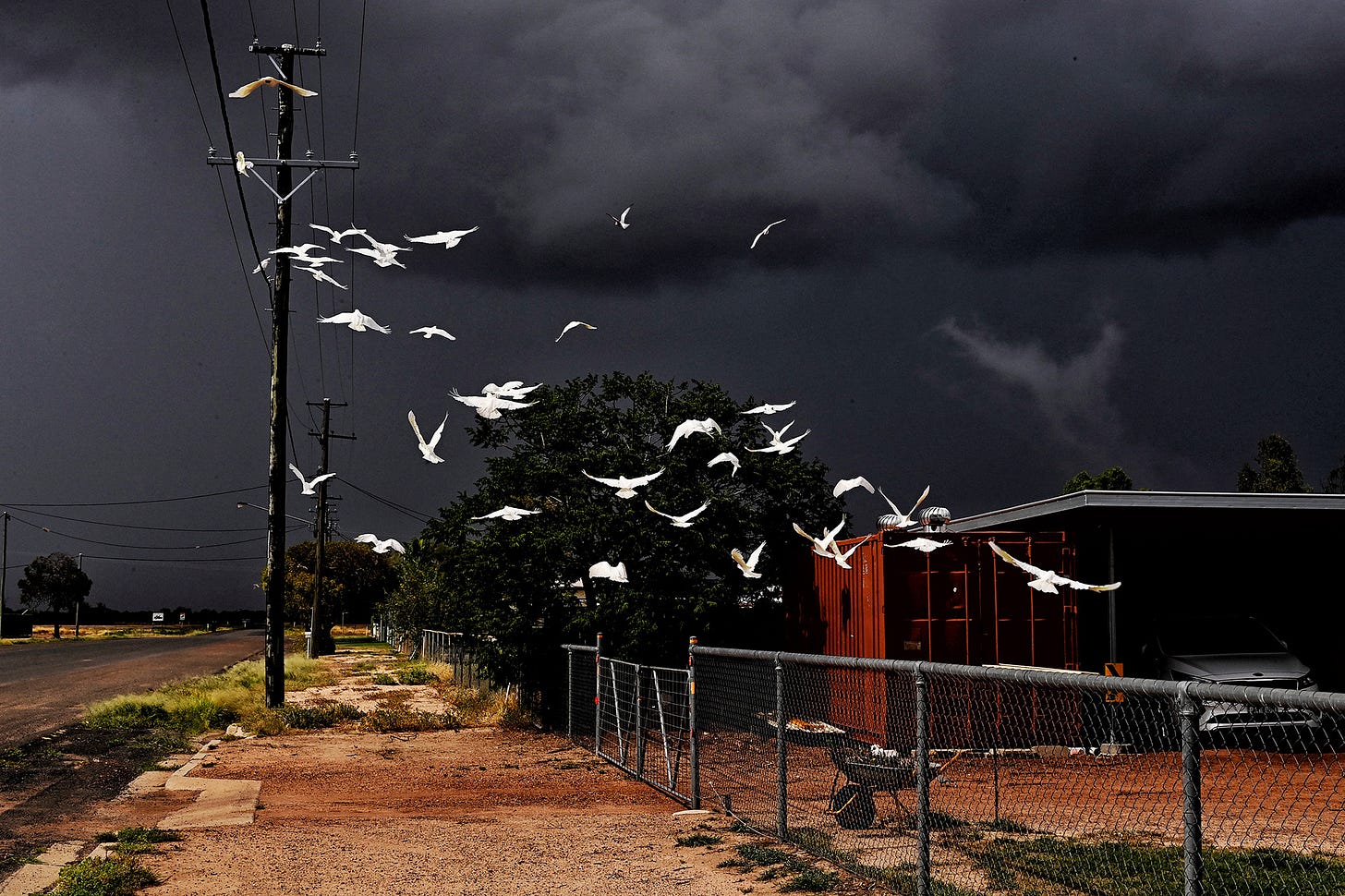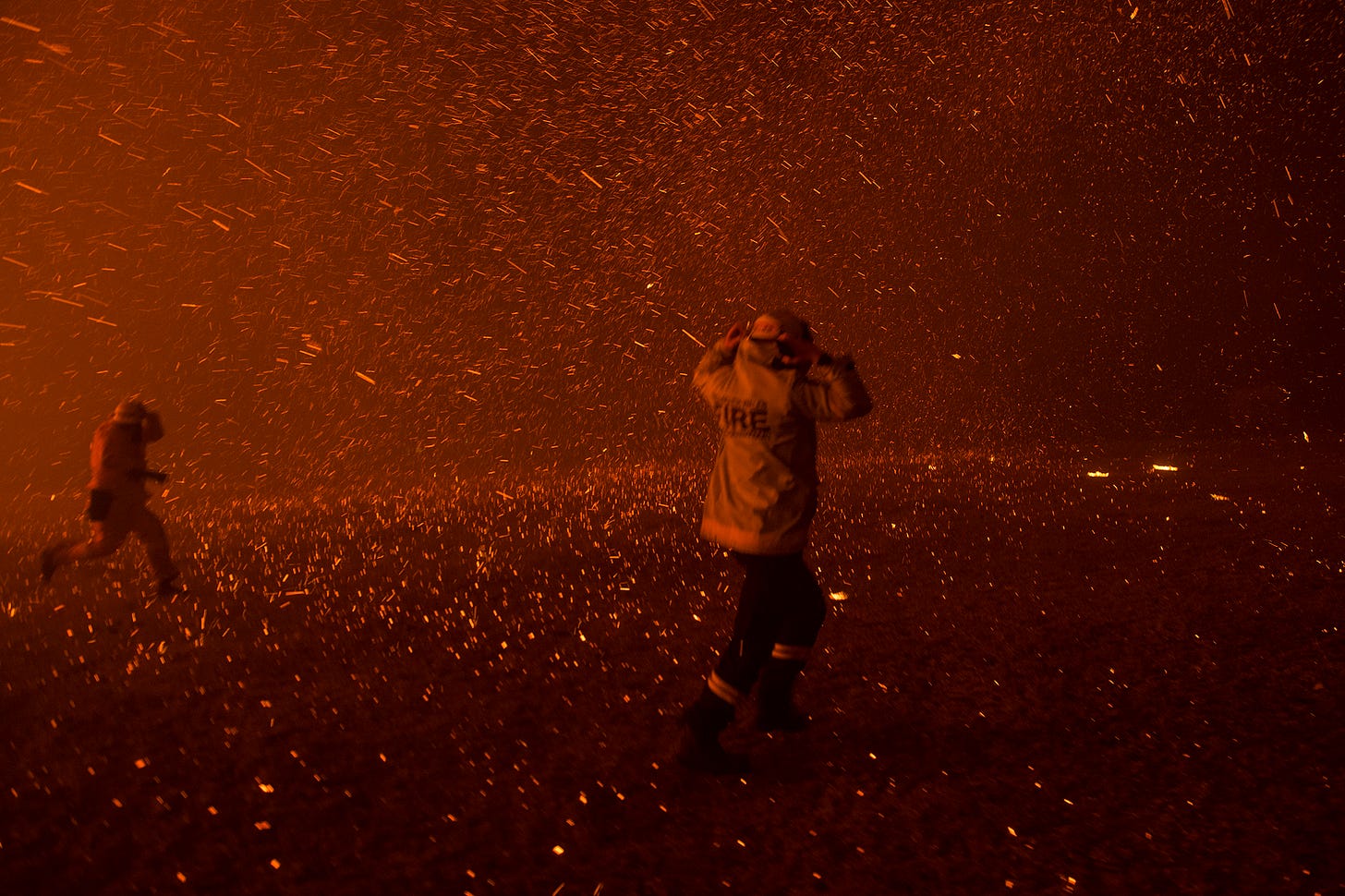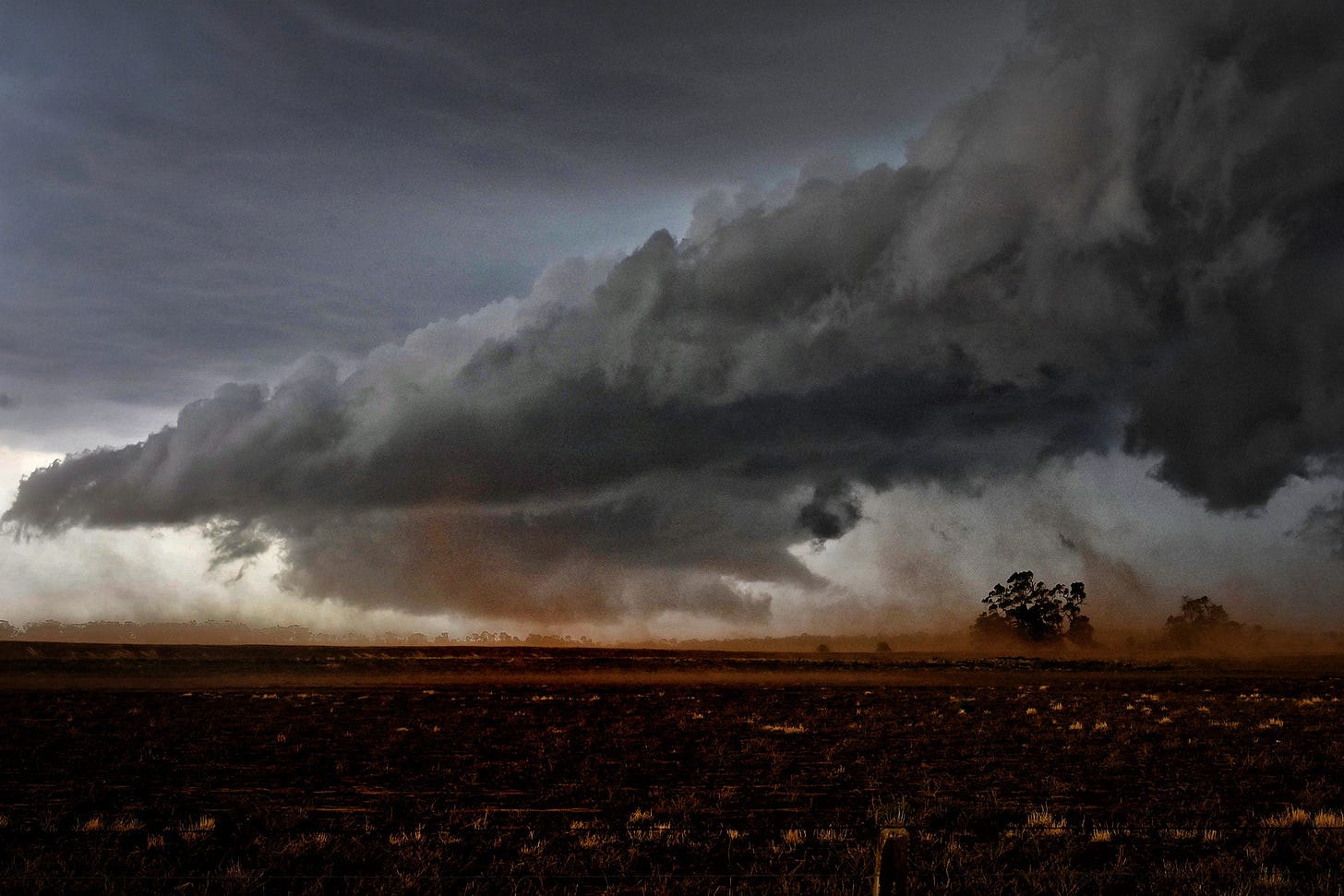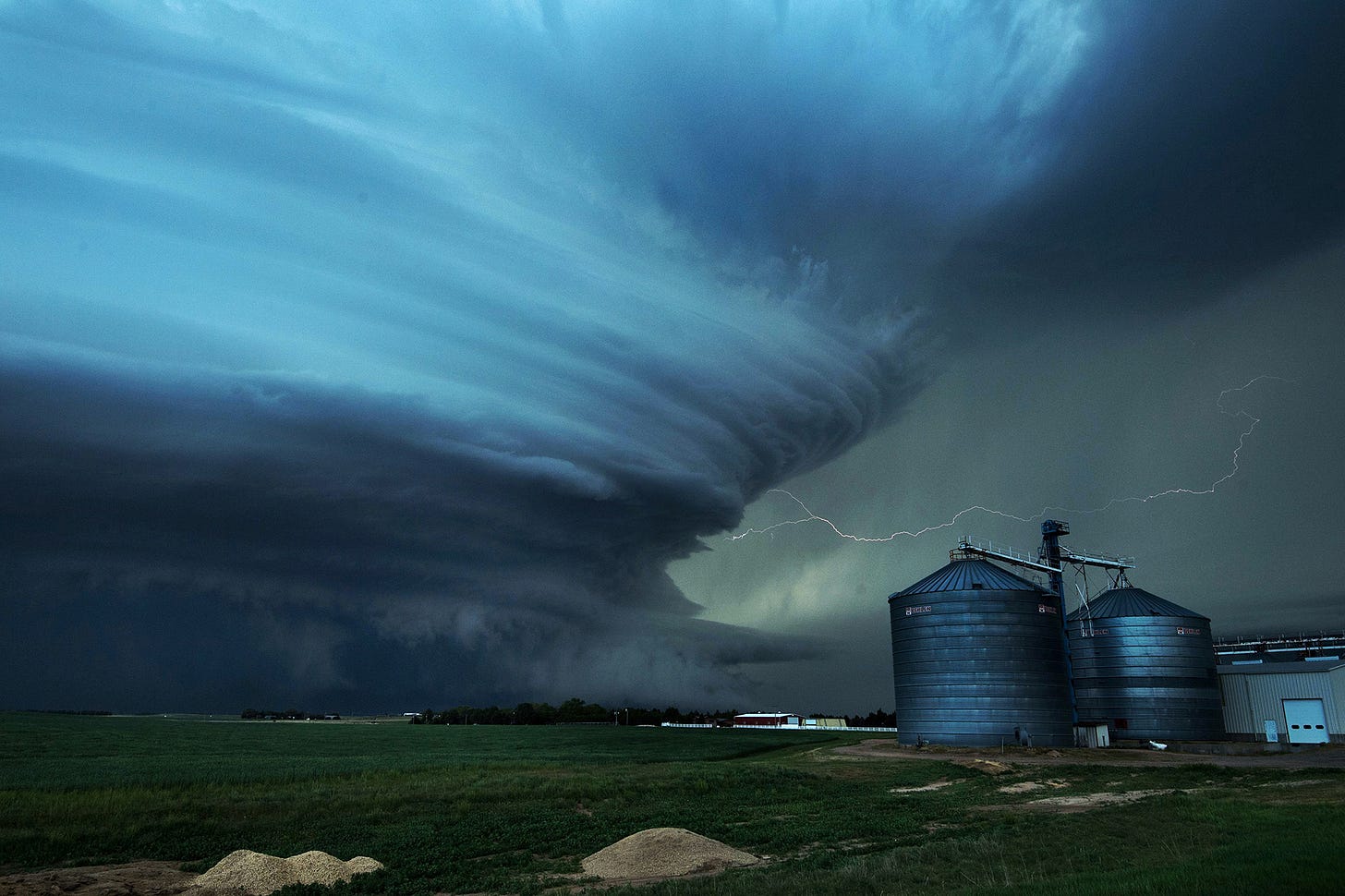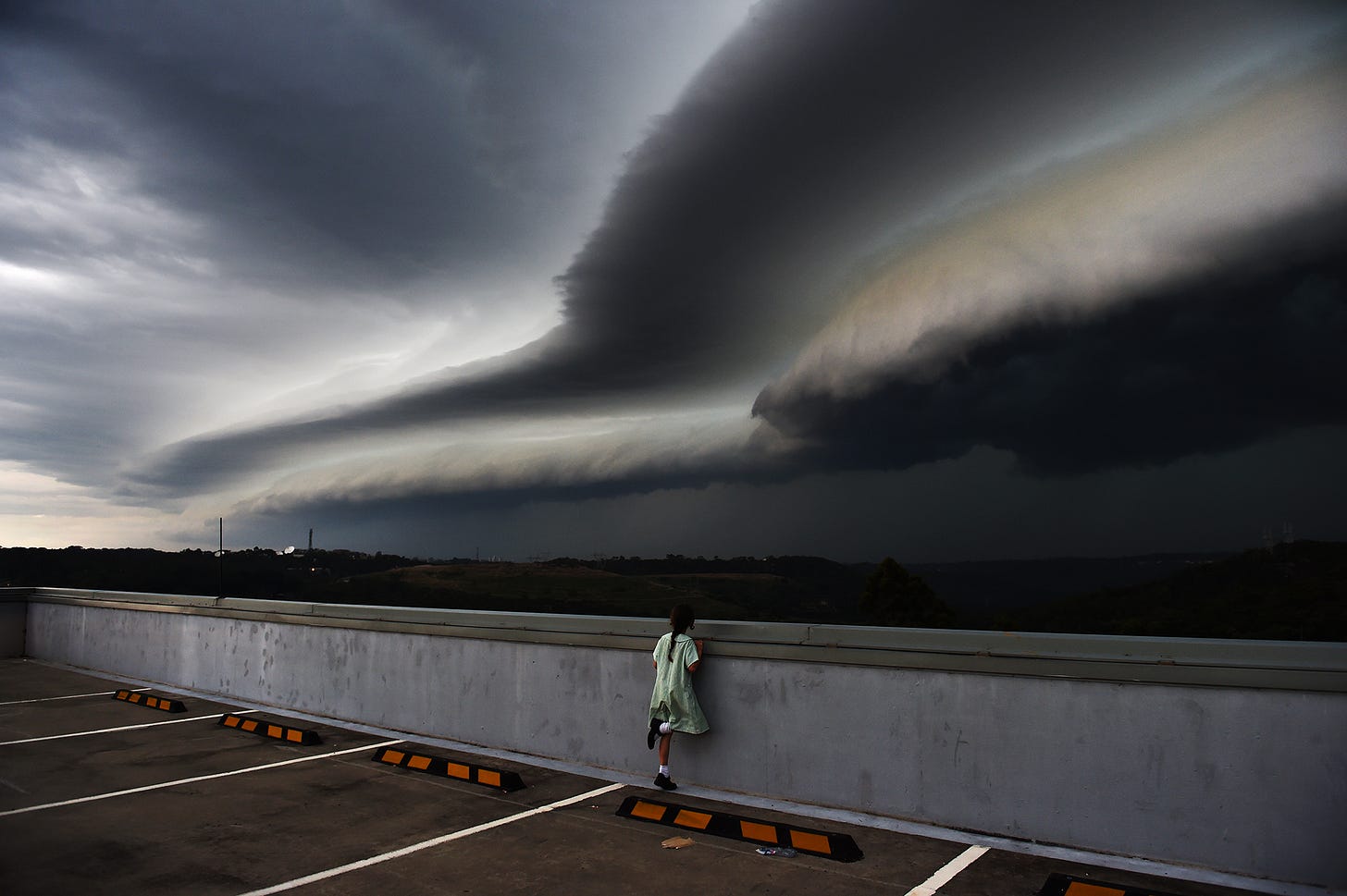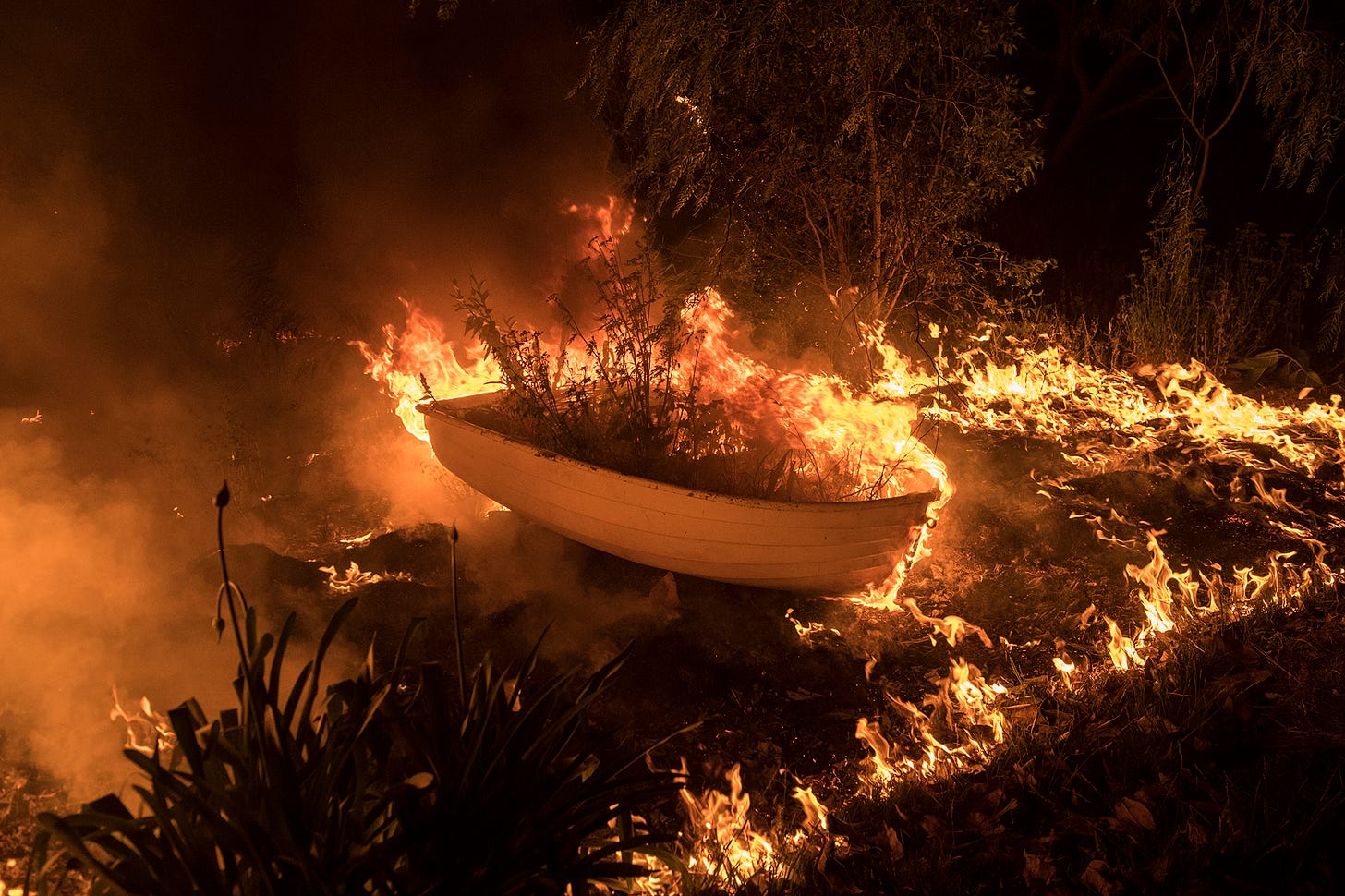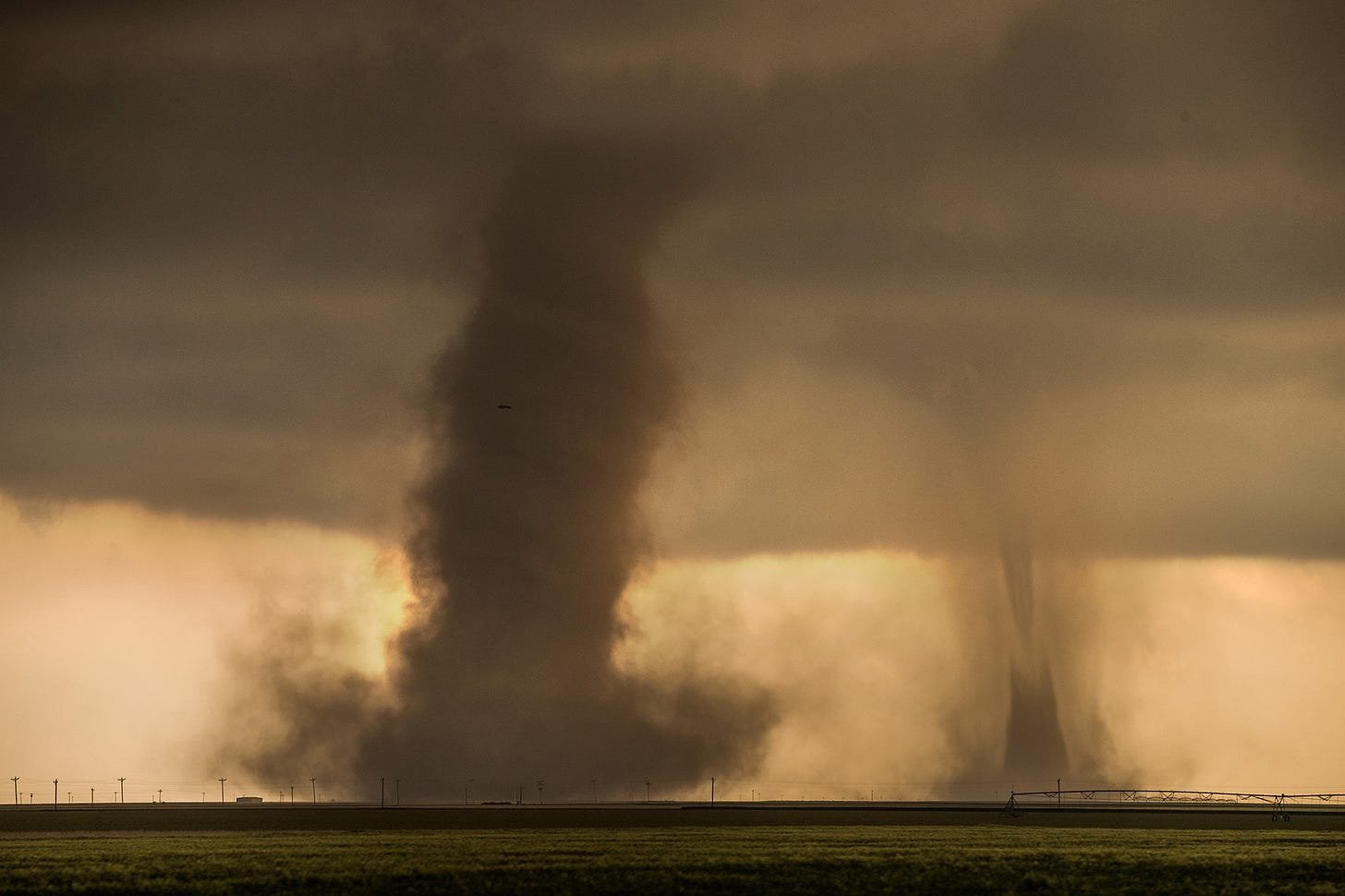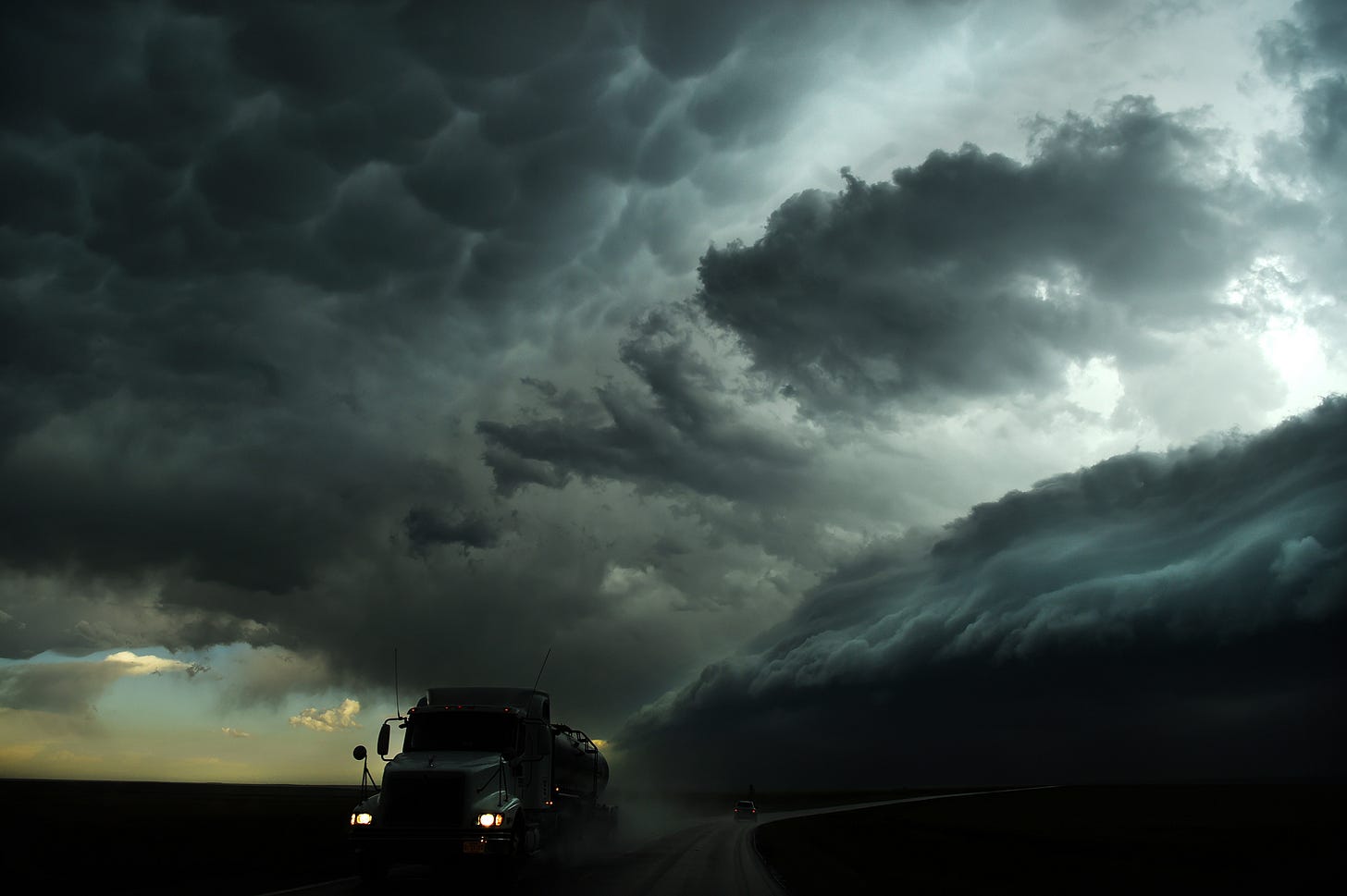Storm Chasing
On the road with Nick Moir searching for extreme weather
I’m on the road chasing storms with photojournalist Nick Moir. We’re about 100 km north of Bourke in western New South Wales, Australia, and as I pose my first questions to Nick a dark grey ‘wall cloud’ manifests under an emerging storm shelf. “Looks like we are going to Queensland”, Nick says with eyes firm on the weather ahead. Moir is a staff photographer at the Sydney Morning Herald and is obsessive about chasing extreme environmental phenomena - storms, fires, drought, tornados.
Over the five days I spent with Nick we drove 4000km (2500 miles). He’d monitor the weather radar, then speed to get us in front of a storm formation. The weather moved quickly; we would have a moment of gazing at a supercell as it grew into a dramatic formation of wind, cloud, lightning and rain before sweeping over us with a downpour and we’d jump in the car and race to keep ahead of it.
Adam Ferguson:
In 2003 when I was starting out I remember being awe-inspired by your coverage of the Australian bushfires that earned you an award from World Press Photo. And you haven't stopped. Your coverage of the 2020-21 bushfire season in Australia was important. How did you get into photography and end up chasing weather?
Nick Moir:
I grew up in the Blue Mountains where we used to get storms and bushfires. Particularly the bushfires always caused anxiety in summer, and we had a number of nasty fires in the region. My dad is an editorial cartoonist and worked at The Sydney Morning Herald and a couple of other papers around Australia. After I did absolutely miserably on my end of high school exams, he said, "Why don't you come and work in the mailroom at The Herald for a while?" Within a few weeks, I came across the photography department, and I met a couple of people including the likes of Dean Sewell and a few of the other staff photographers. Suddenly, all the things that I was interested in, like journalism and history and art, … I was like, this makes sense. And I just grabbed a camera immediately and started going out and photographing my own stuff. Within a few months, they offered me a full-time gig. It was a lot easier back in those days.
Adam:
You're the archetype of the talented person that emerged from the mailroom. I guess people don't come from the mailroom anymore because there's no mail room. At what point did you start to shift your focus primarily to extreme weather and natural phenomena?
Nick:
Around 1997 I started to take photos of storms around Sydney. I can still remember the night I decided I was going to start. I was working on black and white negative film and photographing a lightning storm off the coast of Coogee. I looked up storm chasing and came across the Australian Severe Weather Association. I contacted them and said, "I'd love to come out on a storm chase with you guys." And I did. It would've been '98 or '99, actually in this region where we are now.
I became really obsessed. A guy called Jimmy Deguara took me under his wing and taught me the basics of severe weather and meteorology. At the same time, we started going through a really severe drought, so I rang up the Rural Fire Service and asked them if I could do some training with them. Back then they didn't have any official media training so they said, "Why don't you just do our Basic Firefighters Course, and then you can come along and go onto the fire line".
After that, in 2001, we had a really bad fire season. The Black Christmas fires. Then 2002 and 2003 were also intense fire seasons culminating in devastating fires around Canberra, where a number of people were killed and suburbs were utterly destroyed. While I was covering that, some of the damage I noticed was not bushfire damage, but was tornado damage. It's very different from your normal wind damage, which is straight line damage with everything pushed in one direction. A tornado rips stuff up and pulls it in towards a central place. I thought, this is the power of a tornado. And there'd been almost no evidence ever of a tornado in a bushfire in Australia. There are times when you feel like everything's been done before and everything's been photographed. Well, not everything in the sky and the atmosphere and its impact. I was also covering dust storms and nobody else was. People were photographing fires, but sometimes we'd get to areas before bushfires would start.
Adam:
Before the firefighters?
Nick:
Usually around about the same time. Back then, it'd be my afternoons off, or I would take my Christmas holidays and just go off and chase the weather. Very quickly I had success in getting there. We were getting pictures of stuff that hadn't been photographed before, or if it had, it had been a fluke or an accident. Also combined with the first digital cameras…whereas photography had been the slowest form of media, suddenly, we were able to compete with radio. In particular, in 2002, there were a number of fires that destroyed a lot of homes in Northwest Sydney. The first reports were my pictures of homes burning down with brief interviews with the homeowners. Being able to have that immediacy was really cool.
Adam:
Tell me about the weather patterns that are going on right now and what we're doing out here.
Nick:
We are seeing what's called a high-based storm - if they dump a downburst, it's called a microburst, and if we get lucky we could pick up some 150K an hour straight-line winds. The main game starts tomorrow morning. We've got temperatures in the 30’s (celsius) and very high dew points. I’m hoping we get some supercells.
Over the next couple of days, we may well be the only people who are actually witnessing a storm. The Bureau will have a radar and they'll be watching it, but they've got nobody ‘ground truthing’. If we get into position and show the structure of that storm, or giant hailstones, they'll be able to understand it was a supercell thunderstorm because the photographer underneath photographed and measured these hailstones and were able to confirm what time and where it happened. Matched with radar data, we are able to understand how the atmosphere works in this region.
Beyond the data, it's also showing how often storms occur out here, giving recognition to some of the stuff that goes on in the Bush and recording the emotion and atmosphere of the event on the day for the people who face it. Whether they're firefighters or homeowners. Those are days which a town or a locality marks their time from. They're important events in the life of a place. Sometimes towns will never ever recover. There are towns that have been hit in the US by tornadoes and they just never come back. They go into a slow decline. There are places in Australia to which, whether it's a drought or a massive flood, people hesitate to ever return.
Adam Ferguson:
When you started work documenting fires and extreme weather, that was 20 years ago, and there wasn't a mainstream conversation about climate change. How has the conversation around climate change caused you to reframe the narrative you're contributing to, or rethink the work that you're making?
Nick:
There was talk about warming, even in the late nineties. The modeling was predicting a top end event once every 20 years. And then within 3 years, we had 3 top end events. So it was immediately evident that things were getting hotter quicker than they expected. My role is to document it, it's a scientist's and a climatologist's role to study the trends, but understanding what happens at those extreme events requires a witness.
Adam:
You've been super excited the last couple of days about the intensity of the storms we might get in the coming days. Are we taking risks, is this dangerous?
Nick:
In Australia, the most dangerous thing is driving in extreme winds - branches and trees falling down in front of you is problematic. And then there's hail. There are times when we'll be trying to get in nice and tight to these storms, and that tends to be right under the base of the storm. So we might get lightning barrages. So you don’t want to be the tallest thing around. There have been a couple of times when I've lied down to take a photo because it's safer. Or hidden inside my car. There have been five or six people killed by tornadoes in Australia. So it's just not likely. But in the US, that's when the shit gets real.
Adam Ferguson:
You've been over to the US a few times chasing storms.
Nick:
Six times chasing. Australia is great training because the lack of data here means you've got to really know the sky well, and you've got to visualize the atmosphere in your head. In the US you're spending a lot of time looking at the data, but I learnt how to also watch the sky. The US has a whole pile of things that work together to create the most unstable atmosphere - the Caribbean with all that hot moisture flowing North, the Rockies that puts little kinks into the upper trough. And then also they've got access to polar air coming down over the land, and the ocean heats the air a lot better than the land does.
Adam:
Your process is entirely different to mine. I'm listening to you crunch data and conceptualise physics. Most of my photos come by sitting down with a human and watching their day unfold or negotiating a portrait and considering a personal story.
Nick:
It's actually the same. You analyze them. And you get to predict them and understand them. I'm trying to do the same thing with an atmosphere, and work out what it wants to do. They're easier to understand than humans. They follow physics. They don't follow emotion. If physics says the most economical way for the atmosphere to equalize itself is to form a tornado, it'll do it.
Adam:
When you're looking up at a supercell, what are you thinking about? What image are you looking for? I've seen you really take a diverse range of images - photographs that are layered and use objects or people in the foreground, instead of a conventional landscape of the storm structure on its own.
Nick:
You're just trying to find something interesting in the foreground to add meaning, whether it's the bones of a dead kangaroo. A lot of the places where you are there are no people. So you might be really working with the lines of the road, or trying to get close to a bird, or playing with the fences. If you've got a perfectly flat area, it's challenging. Then there's nothing there, so you have to embrace the nothing. I'm obsessed with trying to get something that is relevant in that foreground to give it some size and context.
Like one of my favorites from a long time ago was just this bearded dragon on the road, this silent witness to this beast storm moving past. And I have to say, I do also really enjoy the challenge of putting together a beautiful composition without a distracting human or other distracting elements in there. It’s really challenging to produce a beautiful photo.
You're not just talking about the storm, you're talking about the place.
Adam:
28 years as a Sydney Morning Herald staff photographer. You have watched the media industry, especially the newspaper business and the photojournalism industry, change dramatically. How's that journey been for you?
Nick:
Generally, it's been a pretty depressing ride as far as the industry goes with jobs going and going and going. However, in the past four years, things have actually stabilized and we've taken on a couple of photographers at The Herald. There have been some positives. Like half our staff are women, and they've come into what was a pretty brutish, male dominated, egoistical, chauvinist environment. At the time, I didn't realize it because I was just a young man. But looking back and hearing their stories, it's like, oh God, it would've been frigging awful. I just can't even describe how over shit I would've been at times. And that was The Herald. It was worse at News Corp and other places. So at the moment it's actually a pretty damn healthy environment. But even though there seems to be lots of people still interested in photojournalism, we need to constantly show and describe our relevance
Adam:
What's been the hardest thing about being a photojournalist?
Nick Moir:
I would not have had my life any other way, but some of those days were dark days. I think about seeing other people's trauma. Whether it's tsunamis, or bushfires, or storms, tornadoes, you brush into somebody's life on their worst day of that life, and it leaves something on your soul. I try to say, whether they're perfectly happy with my being there or not, that I appreciate it. “Even if you hate me, I really appreciate you letting me be here to witness this day.” Usually I bring something back. Sometimes they don't want to know anything about it. But sometimes they do. There was a woman I photographed, her backyard burning, and there was a boat that was on fire, and I managed to get in contact with her and I said, "Look, I don't know if you're interested or not, but would you like a print?" And she was over the moon because it was one of the biggest days of her life, and she knew that that photo had been published and it was a big deal. At this point in my life, those moments are actually more special than awards, when you share a powerful moment with somebody.
And sometimes it's not even about even taking a photo, it's just being a human. You can be a fucking human and a photojournalist. There can be beautiful moments when you don't take a photo, you just go, this is going to hurt this person badly, I don't actually think it's going to do any good to take this picture, and you don't take it.
Adam:
It's so important to engage. It’s an easy pitfall to get caught in the rush of breaking news, or the stress of the logistics when everything moves too quickly. Especially if you're on a deadline. But it can leave you feeling empty at the end of the day if you can’t actually engage… What's the hardest thing about working in remote Australia?
Nick:
Some of the most important stories in Australia are almost impossible to get access to. The most unique and amazing stories are of Indigenous Australia, particularly up in Northern Territory and Western Australia. And it's impossible to tell that story unless you live there and gain trust and respect. And I don't think you can work for the media and do it. There are Indigenous First Nations people up in Arnhem Land and on the islands who have still got a very strong connection to the land, and haven't actually had their world destroyed and have been able to continue their connection. And that's the most unique human story, I think, in Australia. But it's rare that you ever see any work about it that's particularly impactful.
Adam:
There is something incredibly powerful and also humbling, when you look up at such an incredible natural phenomenon like this storm.
Nick:
It actually passes a lot of the tests of a living sort of animal. It eats and feeds, and has waste. It also has a short digestive tract, what it does with the stuff. I mean, all that a human or animal is doing is converting one thing into another for energy. And that's exactly what a storm is doing. The storm we saw yesterday lived for probably four or five hours, and that's a long life for a storm. Some don't live that long. And so it's like a privilege. There were probably only a couple hundred people who actually saw that storm. And we got to be part of its life and actually capture it.
Adam:
That's extraordinary. Have you heard any Indigenous dreaming stories about storms?
Nick:
Certainly there is in Native American culture. The Kiowa on the US plains believe they were responsible for a tornado. The story goes, a couple of boys saw horses for the first time and went back to their shaman, and asked him to make one. And they kind of screwed up and made a tornado instead. Essentially this horse got out of control. They say that the stomping of the horse's hooves is a tornado because what a tornado will do is shoot down to the ground and then come back up.
Adam:
There is also an adrenaline rush to the chase - how does it make you feel when you see a huge storm shelf forming? Is it a spiritual experience?
Nick:
Yeah, it is. I'm really over political, business and economics stories… this idea that there's control going on. It's just such absolute frigging nonsense. When the planet and the atmosphere want to mess humans up, they will do it. It's like seeing these sky deities and in some way paying homage to them by trying to take the best photograph I can, but also trying to get those beautiful photographs of people reacting to them and looking. All we can do is hide from them when they decide to get angry.
Adam:
Will you be chasing storms until your final days - what's the storm you're looking for?
Nick:
I can't imagine stopping. My aim is to get one of the rarest of rare phenomenon, and not just photograph it, but see the world dealing with it. Storms are an astounding phenomenon, like something biblical. That's what I'm after. I went to sleep last night very satisfied with what I got. It's been the most active storm season I've ever covered in Australia. And I haven't had a tornado, although we've had a couple of close calls. But there have been a number of days where I've been able to pick up supercells and witness them. I've had probably about 10 supercells this season; it's lucky if you pick up one or two a year.
Adam:
Are you really overtaking this road train (truck) right now while we pull off this interview?
Nick:
It's all right. I can handle it if you can.
Adam:
I'm terrified.

